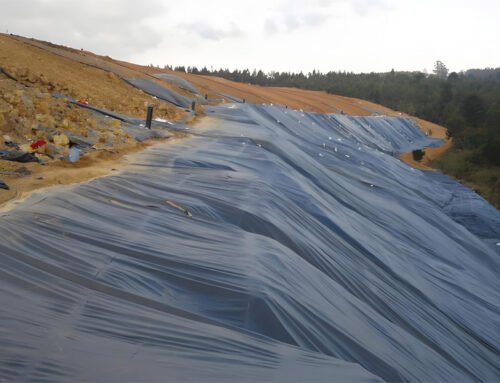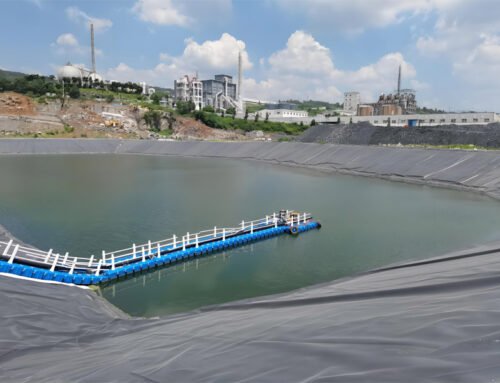HDPE liner installation procedure is process for geoemmbrane installation. HDPE liner is manufactured by the high quality Polyethylene virgin raw material, adding carbon black, antioxidant, anti-aging and UV resistance component. Geomembrane HDPE liner is an effective waterproofing barrier in project.
BPM Geomembrane is the leading HDPE liner manufacturer and supplier. In this article, we provide a more detailed introduction to the geomembrane HDPE liner installation procedure. This installation guide describes the recommended requirements for the installation of high-density polyethylene (HDPE) geomembrane liner. All procedures, operations and methods shall be carried out in strict accordance with HDPE liner specifications and approved engineering drawings.
1. Overview of HDPE Liner Installation Procedure
This HDPE liner installation guide describes the recommended requirements for high-density polyethylene (HDPE) geomembrane HDPE liner installation procedure. All procedures, operations and methods shall be carried out in strict accordance with specifications, drawings and approved engineering drawings.
1.1 What Is HDPE Liner Installation Procedure
The HDPE liner installation procedure, also known as geomembrane installation procedure, involves several important steps to ensure proper placement and effectiveness. While specific procedures may vary depending on the project requirements and site conditions, following a systematic approach is crucial for a successful installation.
Firstly, surface preparation is essential. The area where the HDPE liner will be installed should be cleared of any debris, vegetation, or sharp objects that could potentially damage the liner. The surface should be smooth, compacted, and free from any irregularities.
Next, the HDPE liner sheets are laid out over the prepared surface, ensuring proper alignment and coverage of the designated area. The sheets should have sufficient overlap at the seams to allow for welding.
Welding the seams is a critical step in HDPE liner installation. A professional welding team with experience in welding HDPE geomembranes, using the specified welding equipment, should carry out this process. The installation technical supervisor should be present during each welding operation to provide guidance and ensure the quality of the welds.
Leak testing is an important final step to verify the integrity of the installed liner. This can be done through various methods such as vacuum testing or using specialized leak detection equipment. Any leaks or defects identified should be promptly repaired to maintain the liner’s effectiveness.
To ensure a smooth installation process, it is recommended that the installer has at least three years of continuous experience in HDPE geomembrane liner installation and has completed a significant number of projects totaling a specified area of installation. Additionally, the installation should be supervised by a qualified installation technical supervisor who oversees various aspects of the project, including roadbed acceptance, liner layout, joint welding, and testing.
By following these recommended guidelines and procedures, you can ensure a proper and effective installation of the HDPE liner, providing reliable containment and protection against environmental hazards in landfill or other applications.
1.2 Design Before HDPE Liner Installation Procedure
HDPE liner installation team design geomembrane and joint location drawings based on the engineering design drawings before geomembrane installation. Any drawings shall include a detailed description of all welding and repair methods, anchoring details, sealing of all penetrations and construction of the membrane as shown on the approved issuance of the construction drawings.
HDPE line installation team should provide final “as-installed” layout drawings to reflect any changes to the approved layout and details. Installation drawings shall include the number identification and location of all seams, panels and patches.
1.3 HDPE Liner Delivery and Storage
During transportation and storage, the HDPE liner installation team needs to protect the HDPE liner from mechanical damage, excess soil, and foreign debris that may cause damage to the geomembrane. The geomembrane should be placed on a smooth and flat site or warehouse. When necessary, a sand layer or geotextile should be laid in the storage area to enhance the protection of the geomembrane.
1.4 Quality control
For the purposes of this installation guide, quality control shall be defined as pre-planned inspection and testing of the system
Directly monitor and control installation quality. It is recommended that the geomembrane installation team hire a QC to ensure the installation quality of BPM HDPE geomembrane.
1.5 Quality Assurance
For the purposes of this installation guide, quality assurance is defined as a pre-planned system of activities
It is the HDPE liner installer’s responsibility to ensure that the HDPE liner is installed in accordance with regulations. Quality assurance programs may include testing related to quality control.
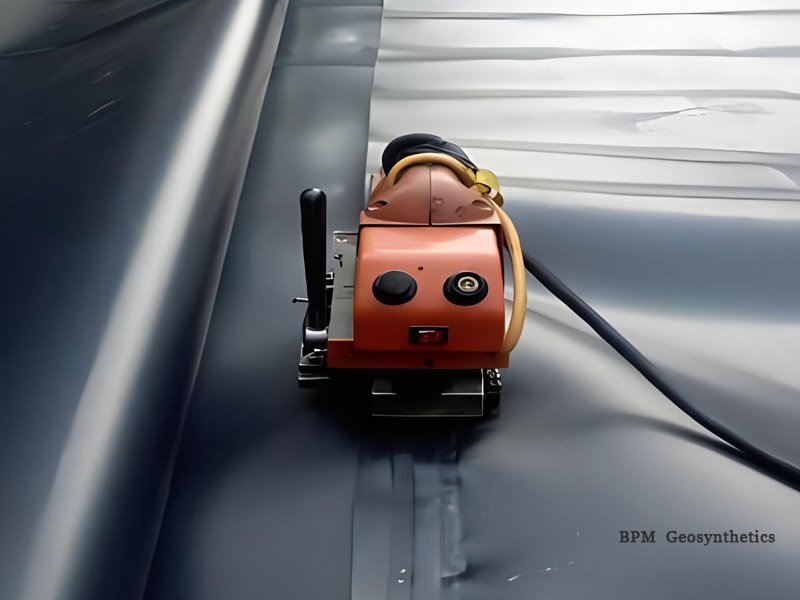
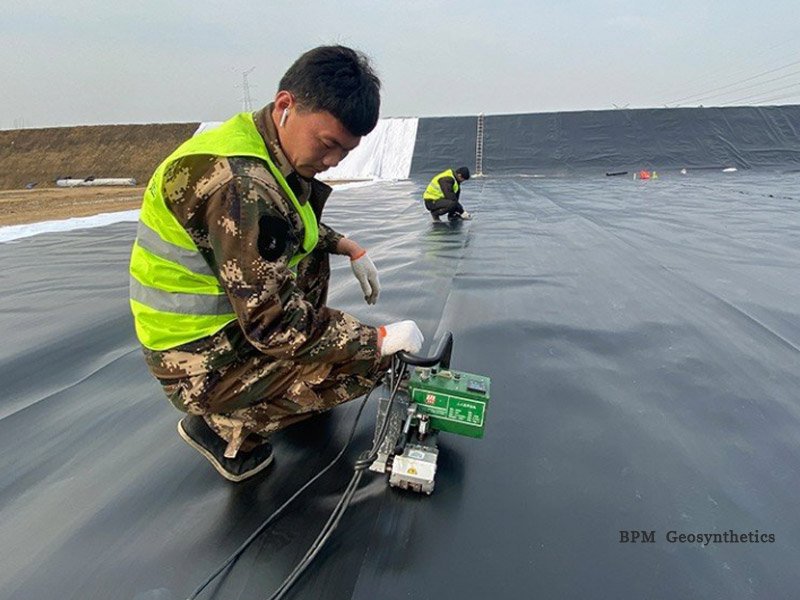
2. BPM HDPE liner installationProcedure
2.1 Geomembrane welding equipment
The following types of welding equipment are usually used when welding geomembranes, including wedge welding machines, extrusion welding machines, hot air welding machines and related measuring and geomembrane cutting equipment. Whenever possible, use the same brand and model of welding equipment.
2.2 Clean the Project Foundation
Ensure that the ground surface on which the geomembrane is laid is clean and flat, and remove debris, sharp objects and large materials. To avoid damage to the geomembrane.
2.2.1 Measuring and Cutting HDPE Liner
As needed, measure the size of the geomembrane and use cutting tools to cut it into the appropriate size and shape.
2.2.2 Laying Geomembrane HDPE Liner
Lay the geomembrane on the foundation ground, ensuring that it completely covers the foundation area, and that its edge extends beyond the foundation edge by a certain distance (usually 20 cm) to facilitate subsequent welding and fixing.
2.2.3 Tightening and adjustment
During the process of laying the geomembrane, tighten the membrane material in a timely manner to eliminate wrinkles, ensure the membrane material is flat and fit, and avoid excessive tension that may cause the membrane material to break or be damaged.
2.3 Welded Geomembrane HDPE Liner
2.3.1 Hot Melt Welding
When using this welding method, we usually choose a wedge welding machine. It is recommended that the overlap of two pieces of BPM HDPE geomembrane should overlap by about 150mm-200mm.
When preparing the area, wipe the area with a clean dry cloth to remove any foreign matter that may cause damage to the weld when welding. Insert the welder into one end of the weld, then clamp the pressure wheel and press the welder. into the weld.
The wedge engages and the drive motor turns on and adjusts the welding machine heating temperature and welding speed based on factors such as weather and environment. If the welder is interrupted during the seam process, the affected area should be marked and repaired.
2.3.2 Extrusion Welding
When using this welding method, we usually use an extrusion welding machine, which is generally used for welding at corners and for reinforcing welds when multiple welds overlap, or for geotechnical engineering. Used when repairing holes in the membrane. It is recommended that the welding area should be prepared by grinding or grinding to a depth not exceeding 0.02 mm. The required grinding along the joints should be performed simultaneously with or within 20 minutes of the jointing operation and should not damage the BPM geomembrane. It is recommended to overlap the membrane by at least 75mm before seaming. During this process, the welding area should always be kept clean and dry. Artificially induced cooling of extrusion welds by water or any other means is not permitted.
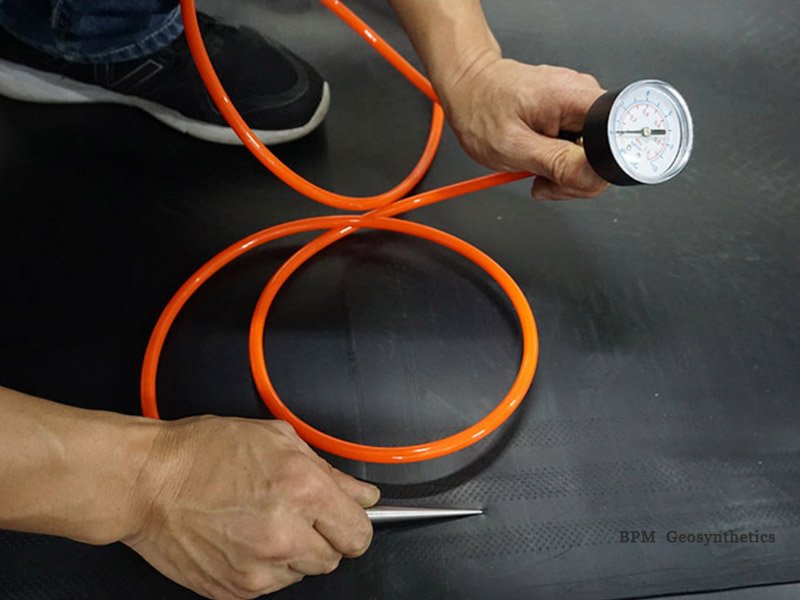

3. HDPE Liner Welding Quality Control
For the welding quality control of geomembrane, we usually use geomembrane liner leakage detectors, vacuum boxes, air pressure testing equipment and other equipment to perform quality control on the surface and welds of the geomembrane.
3.1 BPM geomembrane leakage detectors
BPM geomembrane leakage detector is a high-pressure instrument, which is used to detect the surface integrity of external leakage geomembrane. It can identify damage points caused by transportation, installation and maintenance of geomembrane.
Connect the grounding wire, probe rod and cable, fix the probe brush, press the start button to start the BPM geomembrane leakage detector, select the appropriate detection voltage, hang up the high-voltage pole, and adjust the sensitivity at the critical point of alarm and non-alarm. Then the surface of the BPM geomembrane is detected. Once the surface of the geomembrane is damaged, the BPM geomembrane leakage detector will send an alarm to the detection technician, and the leakage point of the geomembrane can be found based on the position of the electric spark, and then the leakage point can be detected.
3.2 BPM Vacuum Box
A BPM vacuum box, also called a BPM vacuum leak detector, should consist of a rigid shell with a clear viewing window on the top and a soft closed-cell neoprene gasket attached to the bottom of the shell. The enclosure should be equipped with a vent valve and a vacuum gauge that reads one tenth of a bar.
The vacuum box should be connected to a separate vacuum source to create and maintain negative pressure within the box. A “soap” solution consisting of soap and water should be applied to the seams on the front of the vacuum box.
If the geomembrane is damaged, bubbles will appear in the soapy water in the vacuum box and the pressure inside will be lost.
3.3 BPM HDPE Liner Pressure Detector
Geomembrane HDPE liner preesure detector is one of the testing tools in BPM geomembrane welding machine series which is used for testing the welding seam quality.
Pumping 0.2-0.3Mpa of air into the cavity of the geomembrane welding seam.After 5 minutes, if the pointer does not move,that means the welding seam pass the inspection.
Simple operation,convenient to carry and reliable. Especially suitable for geomembrane welding seam test at the construction site.
4. Conclusion
BPM geomembrane HDPE liner installation procedureshall be considered complete when the installer has completed all required deployment, seaming, repair, testing and site cleanup. The geomembrane installation team must submit all required certification and installation test reports to the project party for retention and subsequent project maintenance work.




